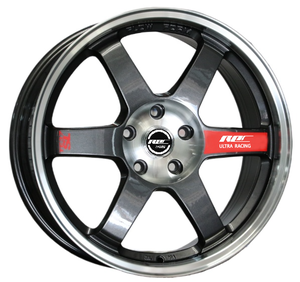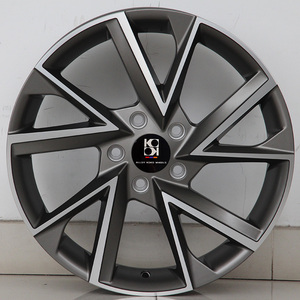(57603 products available)
































































































































































































































There are many types of 16-inch alloy wheels that businesses can consider, including:
Mesh wheels
Mesh wheels are popular due to their timeless design and aesthetics. They have a pattern of interlocking spokes that resemble a woven textile, offering a smooth and sophisticated appearance. Besides their visual appeal, mesh wheels provide excellent brake ventilation, making them a favorite among performance-oriented car owners and those seeking luxury.
5-spoke wheels
5-spoke wheels have five uniformly distributed spokes connecting the wheel's rim to the hub. This design is simple, classic, and easy to maintain, making it a popular choice for many car owners. The 5-spoke structure offers a good balance of strength and weight, which makes it suitable for regular driving and light performance. 5-spoke wheels are versatile and can be found in various finishes and styles.
Split 5-spoke wheels
This wheel is a variation of the conventional 5-spoke design. It has five spokes divided into two sets, creating a more dynamic and complex appearance. The split 5-spoke design improves brake cooling, making it a practical choice for performance cars. Additionally, its distinct look sets it apart from standard wheel designs, making it popular for luxury and high-performance vehicles.
Multi-spoke wheels
These wheels have a complex spoke design, with many smaller spokes radiating from the hub to the rim. This design maximizes the structural strength of the wheel and offers a unique and stylish appearance. Multi-spoke wheels provide excellent brake ventilation, making them suitable for high-performance and sports cars. Their distinctive appearance and performance characteristics make them a popular choice for enthusiasts and those looking for something different.
Forged alloy wheels
Forged wheels are made from a single piece of solid metal using a forging process. This results in wheels with high strength, low weight, and high durability. Forged alloy wheels are often chosen for high-performance cars and racing applications since they can withstand the rigors of aggressive driving and provide better handling and acceleration response.
6-spoke wheels
6-spoke wheels are similar to 5-spoke wheels but have an additional spoke, making a total of six. This design improves the wheel's strength and stability, making it a suitable choice for larger and heavier vehicles, such as SUVs and trucks. 6-spoke wheels may be chosen for their strength and distinctive appearance, which sets them apart from standard wheel designs.
Deep-dish wheels
Deep-dish wheels have a distinctive design characterized by a rim that extends inward, creating a deep trough-like appearance. This design not only adds to the visual appeal but also increases the wheel's strength and stiffness. Deep-dish wheels are popular in the tuning and aftermarket communities, where car owners seek to enhance their vehicles' performance and appearance.
There are several factors to consider when buying an alloy wheel, including the specifications and maintenance requirements. Here are the specifications and maintenance requirements of the 16-inch alloy wheels.
Size
The diameter of the wheel is 16 inches (40.64 cm). This size is ideal for small and medium-sized cars because it offers a good balance between performance and comfort.
Width
The 16-inch alloy wheels have a standard width of 6.5 to 7.5 inches (16.51 to 19.05 cm). The width can affect the car's handling and ride quality.
Offset
Offset refers to the distance between the wheel's center point and the hub-mounting surface. The offset of the 16-inch alloy wheel is 30 to 50 mm. A greater offset allows for a narrower track, while a smaller offset allows for a wider track.
Bolt pattern
The bolt pattern is the number of lug nut holes and the distance between them. The bolt pattern of the 16-inch alloy wheel is 5 lug nuts with a distance of 100 mm. This bolt pattern is common in many small and medium-sized cars.
Hub bore
The hub bore is the diameter of the hole in the center of the wheel that fits over the car's hub. The hub bore of the 16-inch alloy wheel is 56.6 mm. This ensures a precise fit and reduces vibrations while driving.
Finish
The 16-inch alloy wheels are available in various finishes, such as painted, polished, and chrome-plated. The finish can affect the wheel's appearance and durability.
Load rating
Load rating refers to the maximum weight the wheel can support. The load rating of the 16-inch alloy wheel is 500 kg. This ensures that the wheel can support the weight of the car and any additional cargo.
Maintenance of 16-inch alloy wheels
Below are some of the key maintenance requirements for alloy wheels:
1. Clean the wheels regularly to remove dirt and brake dust.
2. Inspect the wheels for damage, such as cracks or dents.
3. Repair any damage promptly to prevent further deterioration.
4. Rotate the wheels regularly to ensure even tire wear.
5. Balance the wheels to prevent vibrations and improve ride quality.
6. Use a suitable tire sealant for tubeless tires, as this can help seal small punctures.
Choosing the right 16-inch alloy wheels for specific needs and preferences involves considering various factors:
Replacing a 16-inch alloy wheel can be a straightforward DIY task, but it's essential to ensure safety and proper technique. Here's a step-by-step guide on how to do it:
Following this DIY guide ensures a successful and safe replacement of the 16-inch alloy wheel. It's crucial to consult the vehicle's owner's manual for specific instructions and torque specifications, as they may vary depending on the car model.
Q1: Are 16 alloy wheels better than steel wheels?
A1: Unlike steel wheels, alloys are more durable and long-lasting. They do not rust, and they have high resistance to corrosion.
Q2: Can larger wheels be fitted onto a car?
A2: Yes, larger wheels can be fitted onto a car. However, this may affect the car's performance and handling. Additionally, the wheel arch and suspension need adequate clearance to fit the larger wheel.
Q3: How should buyers store 16 alloy wheels?
A3: Before storage, buyers should clean the wheels thoroughly. They should also keep the wheels in a dry and cool place away from direct sunlight. The wheels should be stacked vertically to prevent distortion.